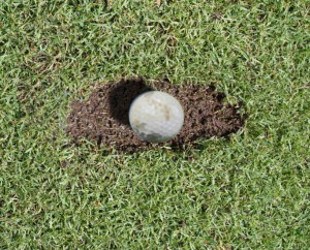
Golf Term: Mud Ball
One of the challenges that golfers often face on the course is dealing with unpredictable weather conditions. One particular condition that can greatly impact a player's shot is known as a “mud ball.” A mud ball occurs when a golf ball comes into contact with mud before being struck by the club. This can lead to an altered trajectory and unpredictable flight path, making it difficult for golfers to accurately control their shots.
Causes of a Mud Ball:
- Rainy weather: When the course is wet due to recent rainfall, there is a higher chance of encountering mud balls. The wet ground can cause mud to cling to the surface of the golf ball.
- Water hazards: Hazards such as lakes, ponds, or streams can also contribute to mud balls. If a golf ball lands near these areas, it may pick up mud when it interacts with the wet ground or water.
- Divots: If another golfer has taken a divot (a chunk of turf) and left behind mud on the fairway or rough, it can affect subsequent players' shots.
Impacts of a Mud Ball:
- Altered ball flight: Mud adhering to the surface of the golf ball can create imbalance, leading to a change in the ball's flight path. This can cause the ball to veer off to the left or right and result in an inaccurate shot.
- Reduced distance: The added weight of the mud can reduce the distance the ball travels. The mud acts as a drag, limiting the ball's potential for distance.
- Lack of control: Mud balls make it challenging for golfers to gauge how the ball will react upon impact with the clubface. This lack of predictability can make it difficult to accurately control the shot.
Tips for Dealing with Mud Balls:
- Inspect the ball: Before addressing the ball, carefully examine it to determine if there is any mud present. Wipe off as much mud as possible using a towel or your finger.
- Change the shot strategy: Due to the unpredictability of mud balls, it may be necessary to adjust your shot strategy. Consider playing a bit more conservatively and focusing on accuracy rather than distance.
- Club selection: Depending on the severity of the mud on the ball, you may need to adjust your choice of club. Using a club with less loft can help combat the reduced distance caused by a mud ball.
- Practice adaptability: In practice sessions, deliberately play shots with mud on the ball to develop a feel for how it affects your shots. This can help you adjust your technique and compensate for any variations caused by mud balls on the course.
By understanding the impact of mud balls and implementing strategies to mitigate their effects, golfers can better navigate challenging playing conditions. It is important to adapt, stay focused, and make necessary adjustments to maintain control over your shots when faced with a mud ball on the course.





